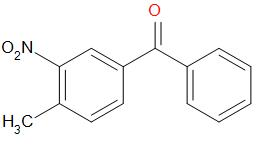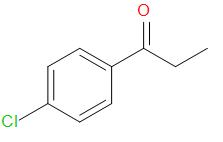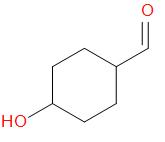
Answer
437.1k+ views
Hint:To answer this question, you must be familiar with the rules of IUPAC nomenclature of organic compounds. The word root of the organic compound gives the longest/ parent carbon chain of the organic compound. We can then attach the substituents on the parent chain according to the positions in the name of the compound.
Complete step by step answer:
In option (i), we are given 4- Methyl- 3- nitro benzophenone.
The word root in the name is benzophenone. Benzophenone is a ketone with both the substituents attached to the carboxylic carbon as phenyl rings. We start the numbering from the carbon atom attached to the carbonyl carbon attaching the nitro group at third carbon and the methyl group at the fourth carbon.

In option (ii), we are given 2-Methyl-4-oxopentanal.
The word root in the name is pentan. Thus we can conclude that the parent chain is a five carbon chain. We start the numbering from the carbon atom attached to the aldehyde group which is the functional group and then attaching a methyl group at the second carbon atom and a keto/ oxo group at the fifth carbon atom.

In option (iii), we have 3-oxopentanoic acid
The word root in the name is pentan. Thus we can conclude that the parent chain is a five carbon chain. We start the numbering from the carbon atom attached to the carboxylic acid group which is the functional group and then attaching a keto/ oxo group at the fifth carbon atom.

In option (iv), we have 4-chloropropiophenone
The word root in the name is phenone. Thus, the functional group is a ketone group. The phenyl ring is the main chain and we start the numbering from the carbon atom attached to the carbonyl carbon attaching the chloro group at fourth carbon.

In option (v), 3-methoxybutanal
The word root in the name is butan. Thus we can conclude that the parent chain is a fur carbon chain. We start the numbering from the carbon atom attached to the aldehyde group which is the functional group and then attaching a methyl group at the third carbon and a methoxy ester attached at the end of the carbon chain.

In option(vi), we have 4-hydroxy cyclohexane carbaldehyde
The word root is hexan. We attach a hydroxyl group at the fourth carbon and a carbaldehyde functional group at the first carbon.

Note:
The functional group gets the smallest number when numbering the parent carbon chain. The functional group is added as a suffix and the substituent groups are added as prefix.
Complete step by step answer:
In option (i), we are given 4- Methyl- 3- nitro benzophenone.
The word root in the name is benzophenone. Benzophenone is a ketone with both the substituents attached to the carboxylic carbon as phenyl rings. We start the numbering from the carbon atom attached to the carbonyl carbon attaching the nitro group at third carbon and the methyl group at the fourth carbon.

In option (ii), we are given 2-Methyl-4-oxopentanal.
The word root in the name is pentan. Thus we can conclude that the parent chain is a five carbon chain. We start the numbering from the carbon atom attached to the aldehyde group which is the functional group and then attaching a methyl group at the second carbon atom and a keto/ oxo group at the fifth carbon atom.

In option (iii), we have 3-oxopentanoic acid
The word root in the name is pentan. Thus we can conclude that the parent chain is a five carbon chain. We start the numbering from the carbon atom attached to the carboxylic acid group which is the functional group and then attaching a keto/ oxo group at the fifth carbon atom.

In option (iv), we have 4-chloropropiophenone
The word root in the name is phenone. Thus, the functional group is a ketone group. The phenyl ring is the main chain and we start the numbering from the carbon atom attached to the carbonyl carbon attaching the chloro group at fourth carbon.

In option (v), 3-methoxybutanal
The word root in the name is butan. Thus we can conclude that the parent chain is a fur carbon chain. We start the numbering from the carbon atom attached to the aldehyde group which is the functional group and then attaching a methyl group at the third carbon and a methoxy ester attached at the end of the carbon chain.

In option(vi), we have 4-hydroxy cyclohexane carbaldehyde
The word root is hexan. We attach a hydroxyl group at the fourth carbon and a carbaldehyde functional group at the first carbon.

Note:
The functional group gets the smallest number when numbering the parent carbon chain. The functional group is added as a suffix and the substituent groups are added as prefix.
Recently Updated Pages
Who among the following was the religious guru of class 7 social science CBSE

what is the correct chronological order of the following class 10 social science CBSE

Which of the following was not the actual cause for class 10 social science CBSE

Which of the following statements is not correct A class 10 social science CBSE

Which of the following leaders was not present in the class 10 social science CBSE

Garampani Sanctuary is located at A Diphu Assam B Gangtok class 10 social science CBSE

Trending doubts
A rainbow has circular shape because A The earth is class 11 physics CBSE

Which are the Top 10 Largest Countries of the World?

Fill the blanks with the suitable prepositions 1 The class 9 english CBSE

How do you graph the function fx 4x class 9 maths CBSE

What is BLO What is the full form of BLO class 8 social science CBSE

The Equation xxx + 2 is Satisfied when x is Equal to Class 10 Maths

Give 10 examples for herbs , shrubs , climbers , creepers

Difference between Prokaryotic cell and Eukaryotic class 11 biology CBSE

Change the following sentences into negative and interrogative class 10 english CBSE




